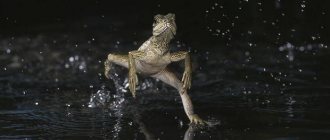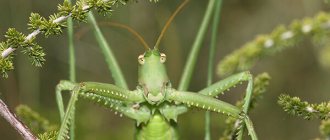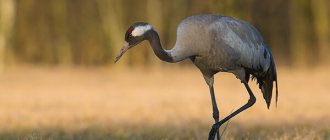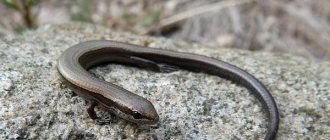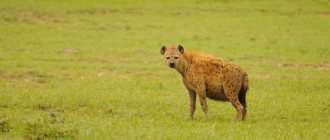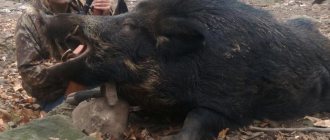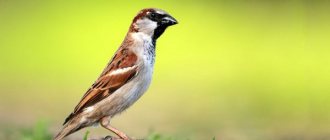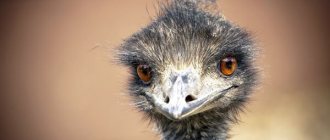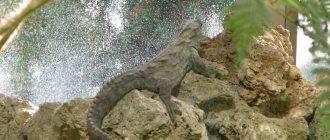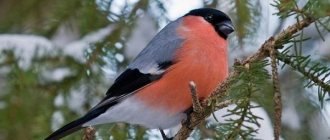External features
Some members of the family, for example, the fire agama, are naturally endowed with a very bright appearance. The Australian moloch, a relative of the steppe lizard, actually looks like a small dragon. Zoologists classify the frilled lizard as one of the most unusual reptiles on our planet.
Compared to its fellow creatures, the steppe agama looks like a simpleton, but it is also, of course, beautiful in its own way.
The steppe agama can reach about 30 cm in length, half of which is in the tail. The head is raised, there is no neck bar, the muzzle is small and rounded. Unlike many of its counterparts, the steppe species does not have ridges on its back and head. The entire body is covered with scales.
Sexual dimorphism is pronounced, males are larger, heavier, brighter, and they have a throat pouch.
The main color does not stand out too much against the background of the area. Calm lizards are usually grayish or greenish-olive. But nature has endowed them with the extraordinary ability to change color, like chameleons. Angry males become covered with blue spots, and their tails take on an orange tint. When frightened or irritated, rusty-red spots appear on the backs of females. The color can change not only from a change in the emotional background, but also from the ambient temperature: the higher it is, the brighter the colors.
Photos of steppe lizards posted in our article allow us to evaluate the ability of these creatures to transform. Note that they are not closely related to chameleons (they belong to different families).
Color change
With increasing temperature, as well as in an excited state, the color of adult agamas changes and becomes very bright. In males, the throat, belly, sides and limbs become dark or even black-blue, cobalt blue spots appear on the back, and the tail becomes bright yellow or orange-yellow. Females become bluish or greenish-yellow, the dark spots on the back become orange or rusty orange, and the legs and tail acquire the same, but less bright, colors as the males.
Area
The habitat includes two unequal parts, separated from each other by approximately 600 km. Scientists believe that the area used to be intact, but about 7 thousand years ago, during the transgression of the Caspian Sea, a gap formed.
Currently, most of the population lives in Central Asia, the northern parts of Afghanistan and Iran, northwestern China, and southern Kazakhstan. Steppe lizards of the second group inhabit the semi-deserts of Dagestan, the Stavropol Territory of the Russian Federation and Chechnya. The Asian part of the range is much larger in area than the European part.
Interesting Facts
Zoologists have discovered poisonous glands in bearded dragons. True, they are in their infancy, and the concentration of toxins in the oral cavity of lizards is negligible, so there is no cause for concern.
The agama does not have the ability to cast off its tail (zoologists call this ability of lizards autotomy), therefore, having lost even the tip of the tail, it will not be able to grow it again.
The British call this species a bearded dragon. The fact is that, sensing approaching danger, this lizard inflates the pouch on its neck, which darkens, spreads its spines menacingly and opens its mouth menacingly. At this time, she really looks a lot like a little dragon.
It is known that this type of reptile, although not to the same extent as a chameleon, can control the color of its body: it will darken if the air becomes cooler, and, on the contrary, it will lighten when the lizard feels that the temperature has increased. But it should be borne in mind that rich body color may also indicate an aggressive mood or illness of the reptile.
This small, peculiar dragon is considered a very intelligent creature. Subject to regular communication with the owner, he is able to remember and subsequently recognize his voice, sit calmly on his hand, clothes, and even go when called.
House of the steppe lizard
Oddly enough, despite the name, steppe agamas do not live in the steppes. They prefer dry deserts and semi-deserts.
Not only natural folds of the terrain, cracks in rocks and holes under stones, but also burrows of neighbors in the habitat (hedgehogs, turtles, jerboas, gerbils) can be used as shelters. Lizards rarely dig their own burrows.
Agamas lead a semi-arboreal lifestyle. They hide from the heat either in the shade of shelters or between the branches of bushes.
Steppe agamas are territorial. The male protects his territory from intruders. Usually one female lives with him, less often 2-3.
Danger to humans and security
The steppe lizard is not dangerous to people. These creatures are non-poisonous, and in case of danger they prefer to run away as quickly as possible. Fortunately, nothing threatens the agama itself: both populations are quite numerous. The lizard is currently not listed in the Red Book.
A lizard is an animal that belongs to the class Reptiles (reptiles), order Squamate, suborder Lizards. In Latin, the suborder of lizards is called Lacertilia, previously the name was Sauria.
The reptile got its name from the word “lizard,” which comes from the Old Russian word “skora,” meaning “skin.”
The largest lizard in the world is the Komodo dragon
Diet
Steppe agamas are active during daylight hours. They prey on insects, worms, arachnids, woodlice and centipedes. Plant foods are also included in their diet and can make up from 20 to 40%.
The steppe lizards themselves also often become prey for larger predators: monitor lizards, snakes, hedgehogs, and foxes. Ornithologists note that buzzards love to hunt agamas: the birds grab reptiles basking in the sun in flight.
Steppe agamas are very common. They are an important link in the food chain.
FLOWER FOR DESSERT
The diet of agamas consists of beetles, butterflies, ants and many other insects, as well as arachnids.
Their lizards hunt both on the surface of the soil and on the branches of bushes. However, in addition to this, they willingly eat plant foods: leaves, stems and flowers of some plants. Their share can range from 20 to 40% of the total diet.
In turn, in nature, agamas often become prey for snakes, monitor lizards, birds of prey and animals, such as long-eared hedgehogs, corsacs or foxes. Ornithologists have more than once observed how buzzards grab lizards sitting on the tops of bushes. As a widespread and abundant reptile species, the steppe agama occupies an important place in the food chain.
Behavior in natural conditions
At the end of October, steppe lizards leave for the winter. In the spring, first the males emerge from their shelters, and only after them the females. In the off-season, the peak of activity occurs in the middle of the day, and in the summer, agamas are mainly in the morning and evening.
Agamas jump beautifully. They can jump from branch to branch at a distance of up to 80 cm. They move quickly on the ground, almost on straight legs, without touching the ground with their tail. In villages you can find agamas moving along vertical clay and stone walls.
I SITT HIGH, I LOOK FAR
The steppe agama is the only species of lowland agama that lives in Kazakhstan. Like all representatives of this genus, it is a bisexual, oviparous, medium-sized lizard, active during daylight hours. It has a round body, covered with uniform ribbed scales, a high head and a rather short muzzle. It does not have occipital or dorsal-caudal ridges, like all plain agamas. There is usually a throat pouch on the neck, which is especially well developed in males. This lizard lives in sandy, clayey and rocky deserts and semi-deserts, preferring areas with shrub vegetation. It can also be found on gentle rocky slopes in the foothills, along the edges of loose sands, along river banks, on the outskirts of settlements and irrigated fields. The lizard rises to the mountains to a height of 1200 m above sea level (Kopet Dag, Turkmenistan).
Agamas use burrows of rodents, hedgehogs and turtles, voids under stones and cracks in the soil as shelters. These reptiles lead a terrestrial and semi-arboreal lifestyle. In the heat of the day, lizards either sit in shelters or climb onto the branches of bushes, protecting themselves from overheating on the hot sun soil. They are able to jump from branch to branch at a distance of up to 50 cm. Agamas are territorial. Males, sitting on a hill, survey their individual territory and protect it from the invasion of competitors. One, or less often two or three, females live in the male’s domain.
Reproduction
Steppe lizards reach sexual maturity in the second year of life, when the body length is only 6-8 cm. Mating, as a rule, occurs in April, and several weeks pass before the eggs are laid (the period depends on the ambient temperature).
The female digs a cone-shaped hole in which she lays her eggs. Most steppe agamas make one or two more clutches with a break of several weeks. Thus, during the season the female brings from 4 to 18 eggs (the number depends on age).
The incubation period lasts about two months. The cubs are born very small, up to 4 cm in length and weighing up to 2.22 g.
CONTINUATION
2-3 weeks after leaving wintering, which lasts from October to March, males acquire bright mating coloring and demonstrate it by puffing out their throats, rising on their front legs and nodding their heads. Females confirm their readiness to mate by clinging to the ground. After 35-45 days, they lay 4 to 18 eggs, digging a cone-shaped hole in the sand. Having completed the clutch, the female crawls out of the hole and fills up the outer passage. After another 50-60 days, the eggs hatch into cubs, which begin to actively feed immediately after the yolk reserve is assimilated. During the season, the female usually makes 2-3 clutches. Young agamas reach sexual maturity in the second year of life.
Like some tropical lizards and chameleons, the steppe agama is capable of dramatically changing the intensity of color depending on its physiological state and “mood.” Thus, in excited males or well-warmed in the sun, the throat, limbs and sides of the body become dark blue, and the tail becomes orange-yellow. In females, the back is covered with bright rusty-red spots.
Keeping at home
It cannot be said that the steppe lizard is very popular among terrarium keepers, but there are still those who want to place such a pet at home. She is inferior in attractiveness to many exotics, but she is still very interesting to watch.
A horizontal terrarium is required for maintenance. Sand is a good substrate as it needs to be moistened from below. It is imperative to install snags and branches in the terrarium for the lizard to climb. Shaded shelters are also necessary.
The desert dweller needs a special temperature regime. During the day, the temperature in the terrarium should be maintained at 30 degrees, and at night, reduced by 5 degrees. At the heating point (directly next to the heater), it should be maintained at approximately 35 degrees. Like many reptiles, the steppe agama requires ultraviolet rays for normal growth and development. To do this, it is advisable to install a special lamp for reptiles in the terrarium.
Agamas are fed finely grated apples, orange and banana slices, sprouted oats and wheat, and lettuce leaves. The diet must include insects, which you can either catch yourself or purchase at pet stores. If you decide to house a pair of agamas, you need to feed them with tweezers. Otherwise, there is a risk that the stronger pet will take food from the weaker one, and as a result, one will overeat and the other will starve. It is equally harmful to health.
It is impossible to keep two males in one terrarium, otherwise they will constantly fight until one of them dies.
The breeding season in captivity falls in May. The female is pre-fed intensively. The eggs are heated in an incubator for approximately 52 days at a temperature of 28 °C.
Some species of agamas are very sociable and friendly, they are happy to be handled and quickly get used to their owners. But the steppe lizard will not be very pleased with the squeezing. Such a pet is perfect for an owner who likes to observe rather than show obsessive attention. Another advantage of steppe agamas is their diurnal lifestyle. In short, the owner and the animal can coexist perfectly without interfering with each other.
The health of steppe agamas is quite good; they cannot be called sickly or too demanding. But still, before you adopt such a lizard, you should get to know your local veterinarian and ask if he works with reptiles.
Natural enemies of agamas
Photo: What does an agama look like?
Among the main enemies of these lizards:
- snakes;
- mongooses;
- large birds.
For birds, the fact that agamas bask in open areas, and usually on a hill, is extremely convenient; it is easy for them to look out for prey from a height and dive onto it. Agama, with all her speed and dexterity, does not always manage to elude the bird, and this is her only hope - she has no chance of fighting back. Their bright colors help birds search for agamas - combined with their love of lying on a clearly visible open point, this makes the agama one of the most easily accessible prey, so birds kill them more often than any other animals.
But they also have enemies among other reptiles, primarily snakes. Here the outcome of the fight may not be so clear, and therefore the snakes try to sneak up on the lizard unnoticed, make a sharp throw and inflict a bite - the poison can weaken or even paralyze the agama, after which it will not be difficult to deal with it. But if she notices a snake, she can run away from it - the agama is faster and more agile, or even inflict serious wounds with her claws if the snake is not very large.
She may even be forced to escape from an overly dangerous lizard, and moreover, it is rare, but it happens that an agama feasts on a snake. Mongooses are not averse to eating both agama and snake - the agama’s agility is not enough against them. Here, as with birds of prey, all she can do is take flight.
Habitats
The steppe agama can be found in Central Asia and Kazakhstan, Afghanistan, Iran, and northwestern China. In Russia it is known in the Eastern Ciscaucasia.
These lizards live in sandy, clayey and rocky deserts and semi-deserts. There are especially many of them where shrubs grow. They are also found in rocky gorges, salt marshes, and dry river beds. They settle on the outskirts of populated areas and along roadsides, and also enter cultivated lands - fields, vegetable gardens, melon fields.
Popular questions
How often should you feed your lizard?
What about the diet is more or less clear, but we will return to this issue a little later, but what should be the frequency of feeding of these reptiles? If you think that lizards, just like house spiders, can live for a long time without food, the main thing is that there is water, then you are mistaken. Lizards need several meals a day, and in the hot season it needs to be fed 3 times a day, while for the colder season it is enough to feed the pet 2 times a day. The time for feeding is chosen when the lizard is active. If you have several lizards, then make sure that the reptiles do not fight over food, therefore, it is better to feed them in different terrariums. After the lizard has eaten, it is better to remove the remaining food. Putting a reptile on a diet and limiting its food intake is not worth it. As a result of malnutrition, the pet may begin to get sick and die.
What to do if your lizard refuses to eat?
This question is very often asked by reptile owners who are not yet accustomed to their status as a lizard breeder. Well, perhaps you just simply overfed your pet, and he decided to arrange a couple of fasting days for himself. Just watch the lizard's behavior - if it is still active, drinks water well, but simply refuses food or eats very little - it's not scary. The reptile may thus be relieving its body from your overfeeding (a symptom of the latter is frequent belching), or perhaps it is clearly hinting to you that what you are feeding it is not to its taste. In this case, it is recommended to reconsider the diet of your pet or pet. It is not uncommon for young lizards to refuse to feed themselves. In this situation, you can try to interest the reptile in breakfast or lunch in the following way - squeeze out the contents of the mealworm and lubricate the lizard's mouth with it. She will definitely lick it off, and then, having tasted the delicacy, will greedily reach for food.
Does a lizard need vitamins?
If you want your reptile to be healthy, look bright, and behave lively, it must include vitamins and minerals in its diet. If you have a vegetarian lizard, you can crush these vitamins and minerals and mix them with rice and fruit. For predator lizards, you can prepare a mixture of food insects and add vitamin powder to it. Some owners even specifically inject mice and rats with vitamins before giving them to their lizard to eat, or inject the latter with minerals in gelatin capsules. To do this or take a simpler path - each owner must decide for himself. The main thing is to avoid those substances that can scare your pet away from food or spoil his appetite... By the way, calcium can be given to lizards in the form of cuttlefish shells or in the form of crushed eggshells (eggs must be raw).
